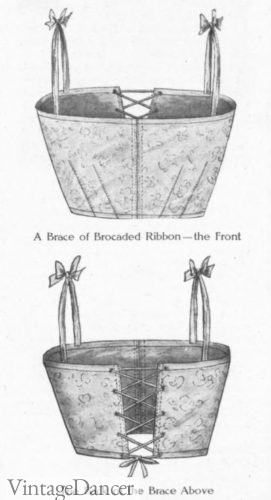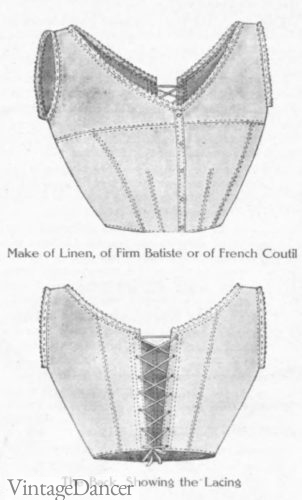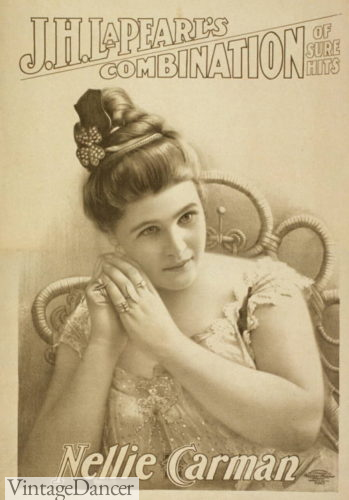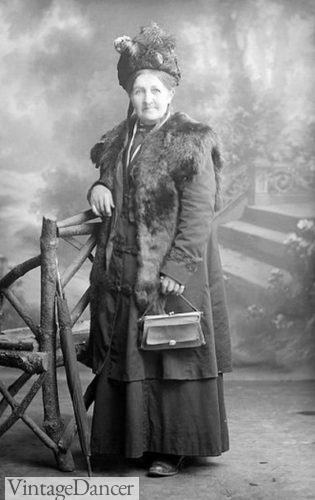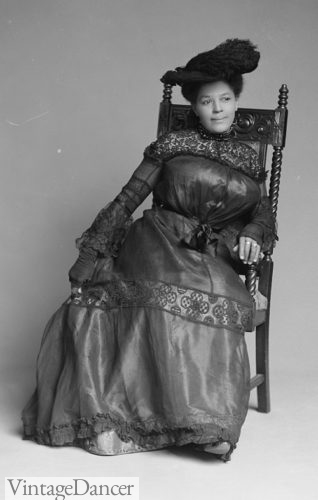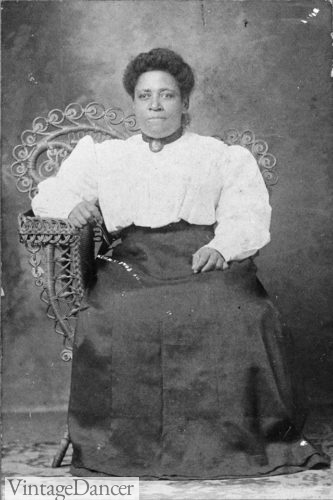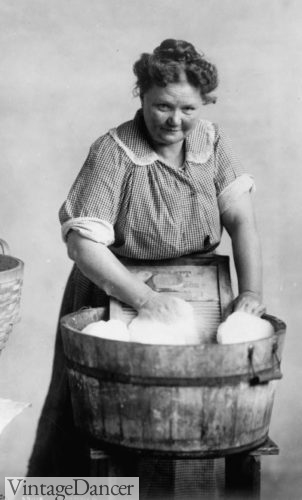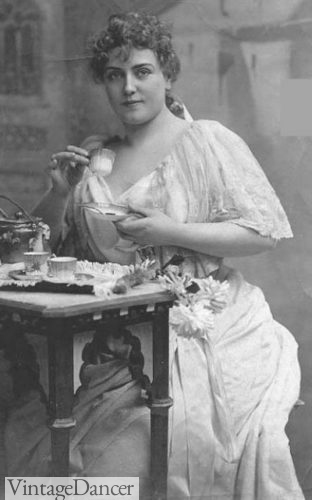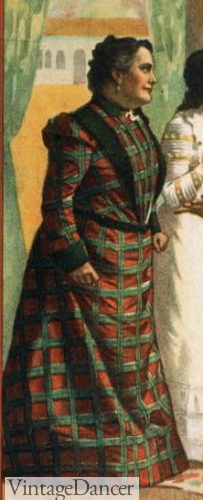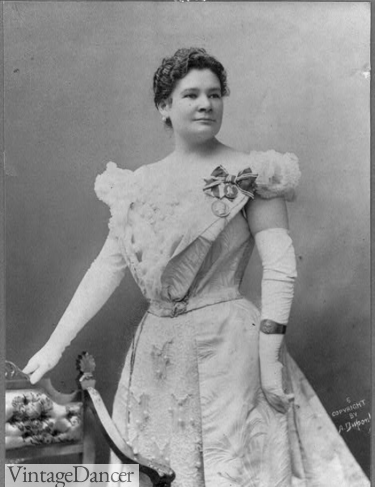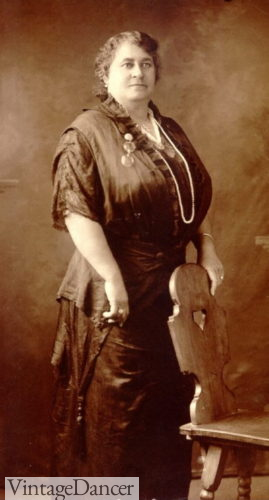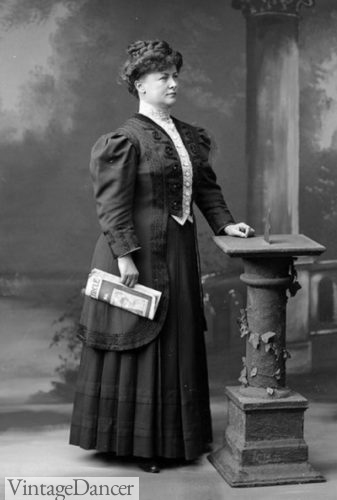
1909 Miss Lambert
Edwardian Fashion Sizes
The idea of a woman being a numbered size wasn’t around in the Edwardian era. Clothing was made to measure, with multiple measurements taken to create a unique pattern and even a mannequin only for that customer.
For mail order clothing companies such as Sears, clothing was sold at first by providing measurements. Large factories sewed the clothing based on those measurements, but this was inefficient. By 1910, most catalog clothes were sold by bust size (in inches) or hip size. This was the first step towards a number system.
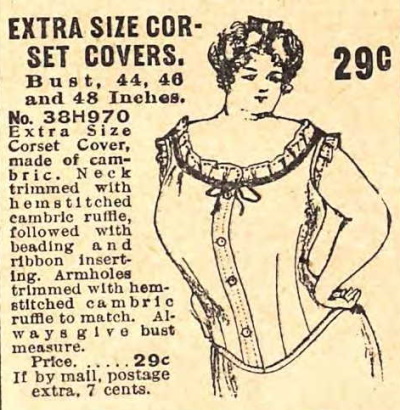
1907 Corset Cover
In terms of shape, women may have been described as slight, average, or stout. ‘Stout’ was the term for what we now call Plus Size or Curvy. Most catalogs sold average size clothes for bust sizes 22″ to 40″. “Extra Sizes” were offered to bust sizes 42, 44, and 46, and hip sizes 60 inches and up. These general sizes were fine for some stout women, while others who were small chested and large hipped found them to be ill fitting. Alternations were almost always needed.
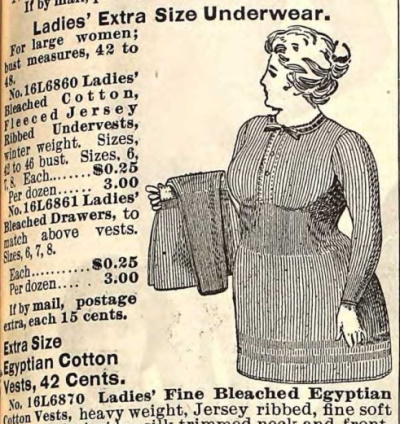
1901 Knitted Vest Lingerie
Not all clothes were available in Extra Sizes. In 1900, only a few corsets, some knitted lingerie, and stockings were offered in plus sizes. Gradually, they added loose fitting garments such as petticoats, corset covers, drawers, and overcoats. Garments needing specific tailoring such a blouses, dresses, and skirts were the last to be offered. By 1912, Sears had almost a full range of Extra Size clothing for Stout Women to choose from.
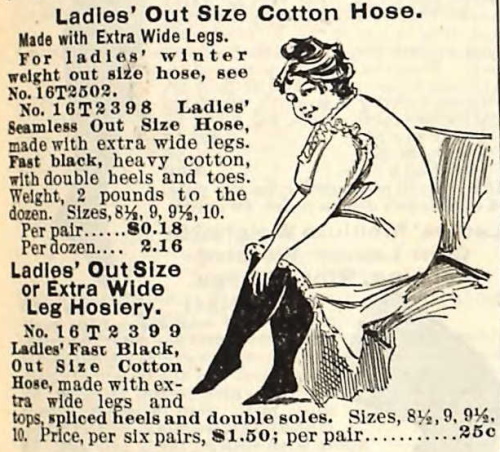
1902 Stockings in “Outsize”
Some department stores also offered Extra Sizes for women that could be ordered, but were hardly ever on display. Specialty plus size shops such as Lane Bryant opened their first store in 1900. Unlike department and catalog shops who sized up average patterns, Lane Bryant’s patterns were built for the plus size figure, offered in a wide range of fashionable colors, and could be customized to odd figures.
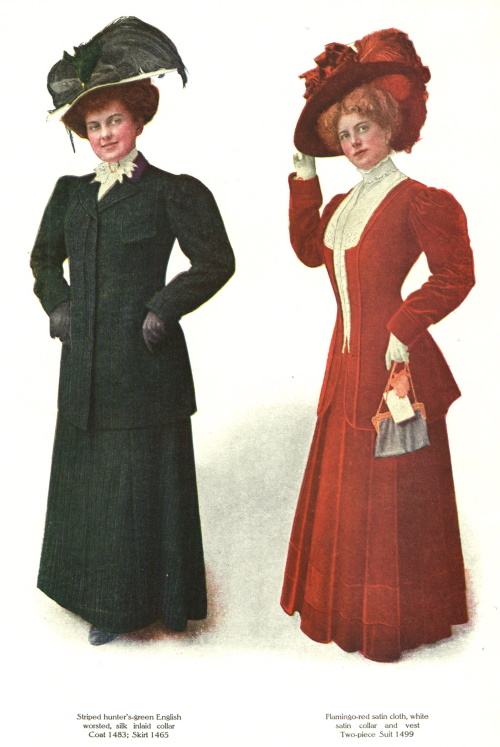
Besides Lane Brant, there was Leonard’s, F.F. Models, Graceline Stout-Style, R and Z Stout by Rueben and Zuckerman, The Rosenbaum, Super Customade, and Le Mere Frocks, who created specific lines for plus size shoppers. Many large city department stores also offered some Extra Size clothing. While most upper class women continued to have clothing made to measure, the middle classes could take a break from the sewing machine and buy new clothing that fit, almost off the rack.
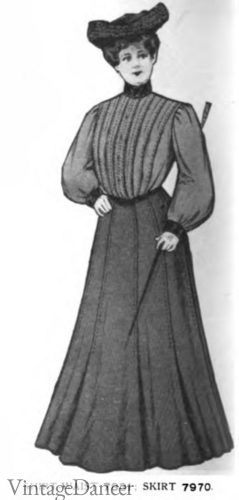
1905 Delineator – An Example of a Good Skirt and Blouse for Stout figures
The cost of ready-to-wear clothing was not inexpensive. Most lower and middle classes hand-made their own clothing, learning from their mothers and reading women’s magazines to get the latest tips and tricks on making current fashions. There were suggestions for choosing becoming patterns, flattering colors, and instructions for making adjustments. An article from 1907 Ladies Home Magazine detailed how to make a bust brace for large chested ladies:
- 1907 Brace (Early Bra Form) for Stout Figures
- 1907 Another Version of a Brace for a Stout Bust
There were the occasional articles encouraging young women to diet and exercise to avoid becoming stout. But for the most part, having a stout figure was not shamed, especially when matched by a mature age or wealthy status. It was estimated that 12% of the female population was Stout in 1910.
The busty, hippy, curvy woman with a round face was greatly admired in the Edwardian era. Women who were average or slight used hip and bust padding to achieve a curvier figure!
Many full-figured opera singers, actresses, and society ladies were photographed and published in newspapers and magazines wearing the most elegant gowns and latest fashions.
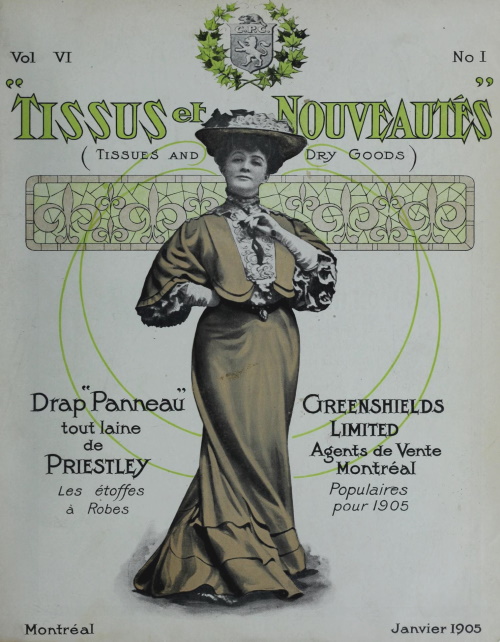
1905 – The Curvy Woman was In Fashion
Plus Size Clothing Advice
Regardless of where women purchased clothing or if they handmade them at home, knowing what designs and color were most flattering to her figure was the job of every woman. Magazines and etiquette books gave ample opinions on how a woman should dress for her body type.
I would like to preface this advice but saying our tastes have changed. Advice in 1900 were for the stout woman to be covered up with muted color, loose draping, minimal decorations, flowing fabrics, and classic designs. The modern curvy woman prefers fitted garments, bolder colors, shorter hems, and many fun accessories. By all means, dress how you feel best in Edwardian fashion and leave 100% historical accuracy to the past. That’s my 2 cents.
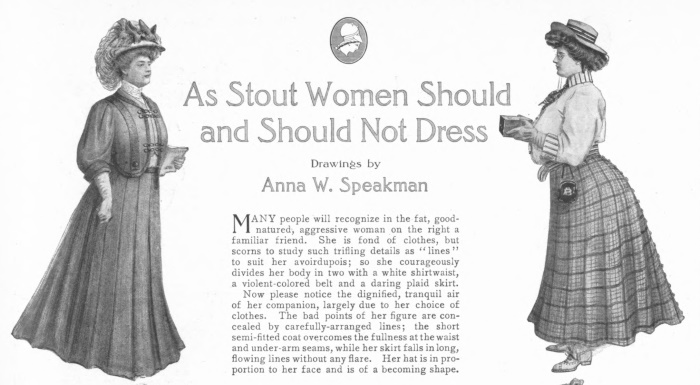
1907 Ladies’ Home Journal advice
Corsets
For the stout figure, the first step was to conform the torso into a flat front, curvy hip, and uplifting bust (or reduced bust if too endowed). The typical overbust corset with hourglass shape was sufficient for most curvy women. The underbust corselet with brace (bra type) was another, less common option for the bust-heavy woman.
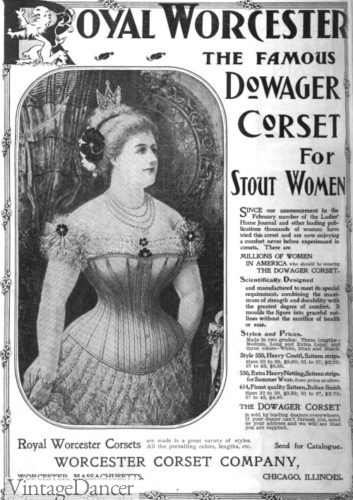
1899 Corset “Dowager” for Stout figures
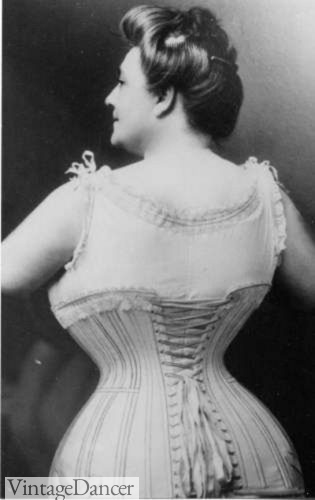
1900 Lady in Corset
Dress Bodice and Blouses
“V-shaped effects and long-pointed basques are as becoming to those burdened with flesh as they are unbecoming to tall, thin women.”
“Long, graceful folds and draperies are admirable for the stout sisterhood, who should avoid short sacques and tight-fitting garments that give the on-looker an uncomfortable impression; there is too much in a small space. Very light colors and thin textures that billow and float should be eschewed by the large, fleshy woman who wishes to give the impression that she possesses the lines of a finely modelled statue.”
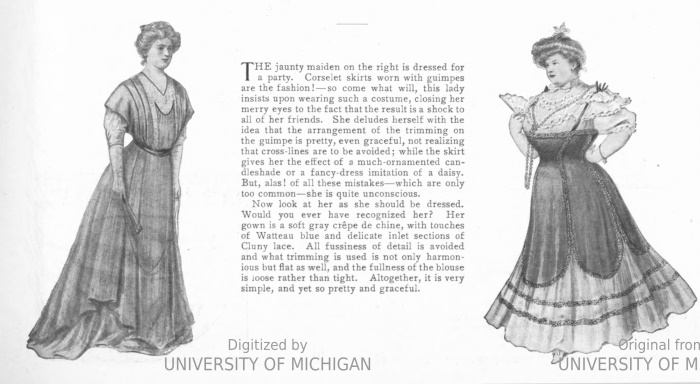
1907 Ladies Home Journal Advice – Minimal, not Flashy
“She should avoid puffs and any suggestion of the pulpy and clumsy, and be careful not to sub-divide the body of her dress by plaits or braids laid on horizontally across or above the bust, or below the hips. Horizontal lines invariably decrease the height; for that reason stout women should not wear dresses cut square in the neck, but should adhere to the graceful V-or heart-shaped cut which has a tendency to give length.”
“The V-shaped cut is most becoming to the short-necked woman, whose aim should be to increase the length of her throat.”
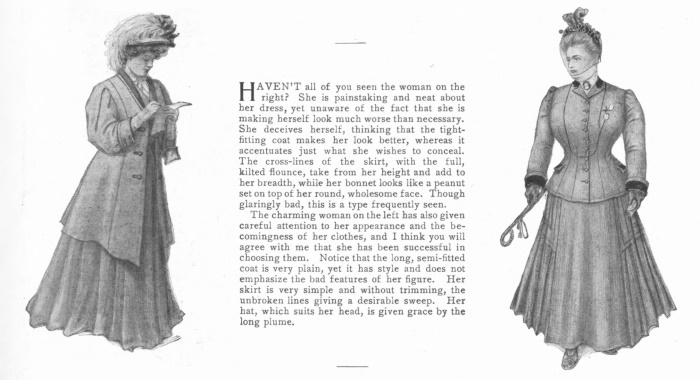
1907 Ladies Home Journal Advice – Loose Coats, not Fitted Jackets
Dresses and Skirts
“The rotund woman with a short waist, sketched in No. 54, may improve her figure, as shown in No. 55, by choosing belts and collars the exact shade of her shirt-waists in summer, and by not cutting off her height by any sort of outside belt on winter gowns.”
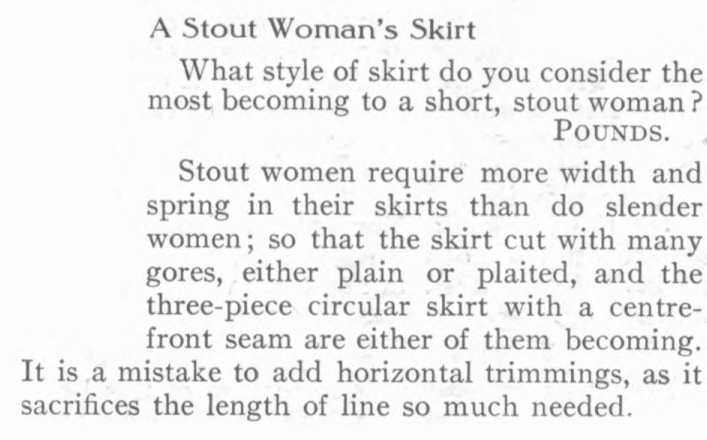
1907 Skirt Advice for the Short and Stout Woman
The white blouse, colored belt, and pattern skirt divides the figure. It is best to keep a blouse under a cropped jacket with matching belt and skirt.
or
“Although stripes increase the effect of height, they also add to that of breadth. A plain cloth basque and skirt of striped material make a happy compromise and can be worn with becoming effect by a stout woman.”
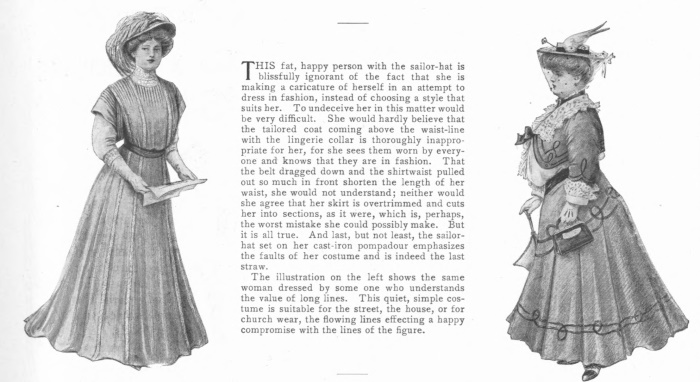
1907 Ladies Home Journal Advice- Simple, linear lines
Quotations from What Dress Makes of Us by Dorothy Quigley, 1897
Colors and Patterns
Most department stores and mail order catalogs sold Extra Size clothing in black, grey, brown, and navy blue. Narrow vertical stripes and small polka dots on house dresses were the only patterns. The idea was that dark colors were the most concealing.
Better plus size designers and fashion commentators suggested a muted palette that included deep burgundy or wine, olive green, mahogany, shades of brown, and royal blue.
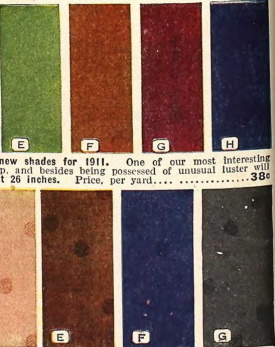
Good colors for Stout Figures
“White, or very light colors, should never be worn by the stout; they greatly increase the apparent size. Large plaids should also be eschewed. Small checks and plaids may sometimes be becoming.”
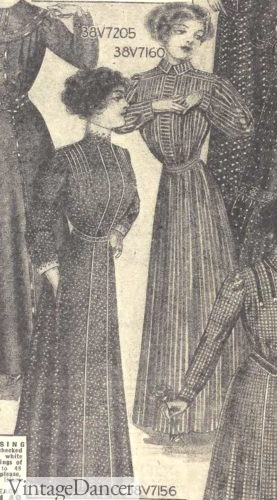
1910 House Dress with Thin Stripes of Grey or Black with Polka Dots, Available in Plus Sizes
“A very stout woman should never wear double skirts or tunics or dresses with large sprawling patterns.”
Plus Size Edwardian Clothing Today
Plus Size Edwardian Clothing 1900 1910s – Where to buy Dresses, Costumes, and Shoes
Photo Gallery
- 1900 Nellie Carman
- 1900-1910
- 1903 Mrs. M.F. Reese
- 1905 Miss Leah Pitts
- 1905 Housewife
- Lillian Russell
- 1907 Check Dress
- Ernestine Schumann-Heink, singer 1899
- 1910s Maggie Lena Walker
Read More Plus Size Fashion History
- 1920s Plus Size Fashion in the Jazz Age
- 1930s Plus Size, Curvy, Mature Fashion Inspiration
- 1940s Plus Size Clothing: Dresses History
Debbie Sessions has been teaching fashion history and helping people dress for vintage themed events since 2009. She has turned a hobby into VintageDancer.com with hundreds of well researched articles and hand picked links to vintage inspired clothing online. She aims to make dressing accurately (or not) an affordable option for all. Oh, and she dances too.
